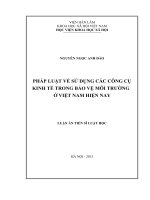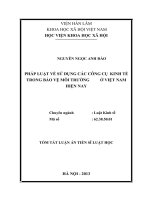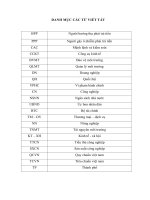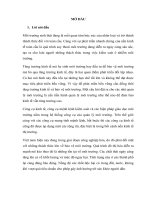Công cụ kinh tế trong QLMT
Bạn đang xem bản rút gọn của tài liệu. Xem và tải ngay bản đầy đủ của tài liệu tại đây (443.32 KB, 3 trang )
10/3/2011
Những vấn đề liên quan đến áp dụng thuế/phí
Bài 5: CÔNG CỤ KINH TẾ TRONG QLMT (tt)
(Market-based instruments)
How to set the charge
May be by ‘trial and error’ (phương pháp thử và
sai) – can be costly with mistakes
+ Choosing an arbitrary change rate and
observing the amount of reduction that occurs
when that charge is imposed.
+If the observed reduction is larger than desired,
the charge should be lowered; if the reduction is
smaller, the charge should be raised.
+ The process can be repeated until the actual
and desired reduction are equal
• Firms will continue to clean up until their MCC
(marginal control cost) reach the level of the
charge.
•With each polluter doing this, they all clean up
until their MCC’s are equal to the charge and
hence ensure cost effectiveness
•How to set the charge to ensure that the
resulting emission reduction is the desired level
of emission reduction?
•But gives an incentive to innovate to lower
costs of control
Cap--and
Cap
and--trade
Can achieve the cost-minimizing allocation
without going through a trial-and-error process
All sources face a limit on their emissions and
they are allocated allowances to emit.
Each allowance authorizes a specific amount
of emissions
The control authority issues exactly the
number of allowances needed to produce the
desired emission level.
These can be distributed among the firms
either by auctioning them off to the highest
bidder or by granting directly to firms free-ofcharge (called gifting)
1
10/3/2011
Cap--and
Cap
and--trade (tt)
Firms are acquired the allowances are freely
transferable; they can be bought and sold.
Firms emitting more than their holdings would buy
additional allowances from firms that are emitting
less than authorized.
By issuing the appropriate number of allowances
and letting the market do the rest, the control
authority can achieve a cost-effective allocation--this system allowances the government to meet
its policy objective while allowing greater flexibility
in how that objective is met.
Lessons
Viêc thiết kế thị trường (market design) quyết
định tính hiệu quả
Sự tham gia của chính phủ đóng vai trò quan
trọng để đảm bảo cho thị trường hoạt động hiệu
quả
Triển vọng cho thị trường tự nguyện (voluntary
market
Những vấn đề liên quan đến sự chỉ định
(allocation)
Các nhân tố khác: thông tin, niềm tin, tính cạnh
tranh...
Examples of CapCap-and
and--trade
the Acid Rain market in the US
the Emissions Trading Scheme in the UK
the proposed Emissions Trading System for
the European Union
the US market in greenhouse gases
Lessons
Environmental services (dịch vụ môi trường)
Scale
Positive service
Negative service
Global
carbon sequestration
biodiversity
greenhouse gas emission
Regional
soil conservation
landslide prevention
water retention
water purification
flood prevention
soil erosion
soil salinity
water pollution (nutrient,
pesticide and sediment)
eutrophication
Local
local landscapes
cultural heritage
air pollution
2
10/3/2011
Rationale of PES
Deforestation
Reference for PES
Conservation
Benefits to land
users
Externalities
/>
$$
Payment flow:
Smaller (or equal) than externality
Need to result in total benefits for ES providers
equal to, or greater than, alternative
Continuous over time period, eg yearly
Need sustainable financing
9
/>itrảdịchvụmôitrườngrừng3.aspx
10
Eco--labelling (Nhãn sinh thái)
Eco
Theo tổ chức thương mại thế giới W TO và Ngân hàng thế giới
WB thì: Nhãn sinh thái là một loại nhãn được cấp cho những
sản phẩm thoả mãn một số tiêu chí nhất định do một cơ quan
chính phủ hoặc một tổ chức được chính phủ uỷ nhiệm đề ra.
Các tiêu chí này tương đối toàn diện nhằm đánh giá tác động
đối với môi trường trong những giai đoạn khác nhau của chu kỳ
sản phẩm: từ giai đoạn sơ chế, chế biến, gia công, đóng gói,
phân phối, sử dụng cho đến khi bị vứt bỏ. Cũng có trường hợp
người ta chỉ quan tâm đến một tiêu chí nhất định đặc trưng cho
sản phẩm, ví dụ mức độ khí thải phát sinh, khả năng tái chế,
v.v…
‘Nhãn sinh thái là một loại nhãn mác cung cấp thông tin cho
người tiêu dùng về sự thân thiện hơn với môi trường của sản
phẩm, hoặc dịch vụ so với các sản phẩm hoặc dịch vụ khác.’
11
3









